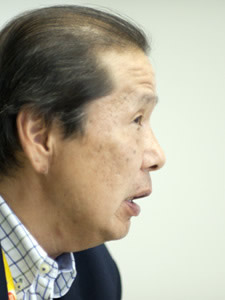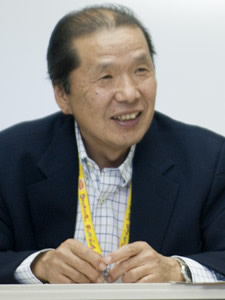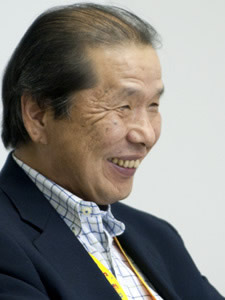Mr. Shigeru Yokoyama Interview VOL.2

Location Testing Difficulties
- ― Was there any difficulties in relation to time constraints for deliverables?
- Yokoyama – To be honest, I had no interest whatsoever of company interests or profit. In fact, I never once even considered it. So I pretty much made up delivery schedules on my own (laughs). Once the project was close to completion, next I thought on when it should be sold. From there I prepared for manufacturing, and at that point I finally had a delivery schedule. So in that sense, time wasn’t much of an issue at all.
- ― Iwatani-san (*21) who worked on Pac-man said before that scheduling wasn’t as strict as it is now, so there were a lot of opportunities to make adjustments in the schedule. He also mentioned that that’s the very reason why a masterpiece like Galaga was born.
- Yokoyama – To a certain degree that was only possible because Nakamura-san was so forgiving. But a bigger reason was probably because the company had the luxury coming from Galaxian and Pac-man (laughs).
- ― Were you able to sense whether the game would be good through development?
- Yokoyama – Yes, when conducting an internal evaluation of the game. Once we hit a playable point, we had everyone give it a shot. It’s then that I saw whether they were enjoying it or not. Seeing everyone enjoy the game, in particular our female staff, made me confident that it’s going to do fine.
- ― That’s good to hear that the game was released with confidence.
- Yokoyama – But, when we conducted location tests (*22) and got a low turn in income (*23), that scared me a bit. The normal playtime for video games of then was about 3 minutes, but for my game, it took an average of 7 to 8 minutes. That was why the turnaround in income wasn’t great. I recall being complained about it, but players would play the game for a long time, and I figured the income wouldn’t drop drastically, so I asked that the game be released as-is. Still, looking at it from an operator’s (*24) standpoint, having a high-income return from installment is preferred, so in the end our Marketing made the call on how many units would be manufactured.
- ― But, the end result was that the income was good and the game became a long seller.
- Yokoyama – The other thing I felt confident about was that when Iwatani-san, who wasn’t directly involved with the game, mentioned to me while playing the game that there he sensed that a lot of thought was placed behind the game. What he said and working on the game balance, structuring the Challenging Stage, and seeing the music and sound effect added by our sound staff to the part when the flags appeared at stage clear, all of them lifted my motivation. His words was something along the line of, “everything was made to detail, so I think the game will become pretty addictive.”
Thoughts Behind Instruction Cards

- Yokoyama – (points to the wording used on the instruction card) We had a huge argument over the wording here in terms of putting focus on it.
- ― You mean the “Maruhi Kougekihou” (Secret Attack) part? The wording was a source of argument?
- Yokoyama – Yes. We had a graphic designer to handle the designs, but coming up with the wording was part of the work under planning.
- ― The first thing written here isn’t about how to play the game.
- Yokoyama – At first, I wrote it so that it explains how to use the joystick and buttons to control and shoot, but that came out really bland. So I focused on having this (Dual Fighter mode) because it was a key feature to the game.
- ― With Galaxian already released, most people then already knew how to play the game, so what you have here was probably the right approach.
- Yokoyama – Nakamura-san was very particular about the wording here, and each time I took it to his office he would tell me “no.” After how many times I bothered him, in the end, he told me to stop goofing off (laughs).
- ― What you said sounds much like what I heard before about President Nakamura in that he was very particular over game logos and other detailed parts.
- Yokoyama – Well, we conducted our first location test at a game center in front of Nishi-Ogikubo Station, and at that time not a single person used Dual Fighter mode.
- ― Ah... Well, that’s not surprising.
- Yokoyama – All everyone does is avoid shots. The game came with an instruction card, but I couldn’t go and blab to them on that feature or else it would defeat its purpose (laughs).
- ― Sad considering the person who worked on it was right there (laughs).
What is Namco?

- ― Do you spend a lot of time when coming up with ideas?
- Yokoyama – I put everything I got in coming up with ideas, but I don’t think about it at the company. I usually think about ideas at home or when I step out of the company.
- ― So you spent most of your time in the company doing direct work?
- Yokoyama – Right. I would be creating the data or writing things down as needed. Iwatani-san was a very smart person, and in turn, I wasn’t the sharpest person around, so I would keep thinking and anything which popped-up I would write them down. I’m the kind of person who builds something while thinking, so it usually takes a while for me to come to a conclusion. That’s why I don’t do ideas while I’m at the company.
- ― You must really place a lot of thought behind your ideas. I assume you haven’t experienced much failures in relation to actions performed after thought.
- Yokoyama – Well, that’s because the games back then could be handled by one person. That’s not possible with current game development (laughs). I guess in that sense I was blessed with my work conditions.
- ― Were there any games you played often back then?
- Yokoyama – Back in middle school and high school, I used to go bowling, so I would play pinballs while waiting for my turn. Back then there weren’t many video games.
- ― That’s right. A lot of bowling alleys used to have pinball machines.
- Yokoyama – I started playing video games when Breakout was released, but in terms of addiction, that really hit when I started playing Space Invaders.
- ― Another shooter was released from a competitor at the same time Galaxian was released, but were you influenced at all by that other game?
- Yokoyama – If its influence we’re talking about, I used to reference Atari’s (*25) games. I really didn’t refer to games released domestically in Japan. I think most everyone was like that back then. Everyone would check each other’s games out without referencing them.
- ― Back in the days, Namco was a company that stood out from the rest for me. Was there anything you were mindful of, such as how fun a game is or of its quality?
- Yokoyama – Mmm... In relation to your question, I’m often asked what Namco is. I don’t really have a philosophical view on it since every developer’s personality are different. But 1 thing which is common among us is that we always put out our very best. That applies to every bit (*26) of data available, which is why I test everything to whatever extent possible. Either that or I simulate things on my own. These actions are all in line with putting out our very best. This stance isn’t something of choice by creators. We place a lot of thought behind how we want to entertain our customers or how a game should be played, and I think that’s the right balance needed for people like us.
- ― Keeping the customer foremost in mind isn’t something that’s easy to do.
- Yokoyama – What helped was that all we had to do was to do things which our other competitors didn’t do. After Space Invaders was released, everyone started to follow that game. We also followed with Galaga and Bosconian, but on the other hand, we created games like Rally X and Dig Dug, too. This was because, where there’s no competition, there’s an untapped market waiting for us to explore. Also, it isn’t fun just making an “inspired” game, right?
Message to the Next Generation

- ― Another person was making the series from Gaplus (*27), correct?
- Yokoyama – Gaplus was the debut game that was released by my junior, Nakatani (*28). After Dig Dug debuted, games like Pole Position and Xevious was released, right? By then, my duty was mostly just overseeing the work that my juniors were working on.
- ― So in terms of involvement, you were most involved in Galaga?
- Yokoyama – I believe so, but my debut came from the game I made called Cutie Q (*29).
- ― I believe Cutie Q was released before Pac-man. That makes it Namco’s first character based game, correct?
- Yokoyama – That was made simply because we wanted to make 1 more game after the release of Gee Bee and Bomb Bee (*30). Sawano-san was in charge of Galaxian, Iwatani-san was in charge of Pac-man, and I was in charge of Cutie Q.
- ― I believe Cutie Q was released before Pac-man. That makes it Namco’s first character based game, correct?
- Yokoyama – Yes, the game came before it and about the same time as Galaxian. The monster design for the game was done by Iwatani-san.
- ― Do you have any messages you’d like to relay to our aspiring developers?
- Yokoyama – Hm... Thanks for the predicament (laughs). Someone said something similar to me during my introduction when I attended a camp for upper management. For me, most of the games created was in tandem with the programmer, Ogawa-san. That’s why I knew every nook and cranny of the games we came up with and created. But nowadays, development is a lot larger, so I’m hoping aspiring youths will try and experience various things too. Sure you can shoot to become the best programmer, planner, designer, audio designer, or more, but game creation, at its root, is based on people wanting to create games. So getting to know and work on the various aspects involved, such as creating designs, coding programs, crafting music, cutting features, and more, will lead a person to success. That’s why I’m trying to create an environment where such an opportunity exists, or at least I’m thinking about it.
The Beloved Galaga

- ― What’s your thoughts on why Galaga became such a long running hit?
- Yokoyama – I think that’s because we designed the game so that players would be able to enjoy the game for a long time, such as through the balance in difficulty, and various features offering addictive game play. Oh, and I think the game’s simplicity is another factor. I mean, we didn’t even need to put any instructions on how to play the game onto the instruction card (*31).
- ― Did it take a while to balance the game difficulty?
- Yokoyama – Back when I was working on the game, it didn’t really have that much content, so I kept working on the game balance. But that didn’t mean it was easy to do. I would come up with multiple patterns for even a single parameter to make a call on what to use.
- ― So that’s why the game is balanced so that anyone can play the game.
- Yokoyama – Before conducting a location test, I had a lot of employees play the game. We had non-gamer girls, and hardcore gamers of my same age then, and the approach on how they each played the game were starkly different. But unlike Galaxian, which had a more stoic approach, Galaga had the rapid-fire feature, so even our non-gamer girls had fun playing the game, more in relation as being a stress reliever. This stress relieving concept was something I really liked, so I tried to make things easy to enter Dual Fighter early within the game.
- ― With the 30th anniversary here, is there any thoughts you had for players who are still, to this day, playing Galaga?
- Yokoyama – Unlike Pac-man, the game is far from where I used to work on. Even if it seems old, it is in Namco Museum (*32) where a lot of people are playing the game, and the game went on to create Galaga Legions (*33) too. I couldn’t be happier seeing the brand still alive in this age.
- ― It is a well-known property worldwide.
- Yokoyama – In particular, I was very happy when I was told by a middle-aged female bus guide that she knew about Galaga. It was when I went with a bunch of others to the U.S. The bus guide knew that we were from Namco, so when I told her I made Galaga, she seemed really happy to know that. That’s when it hit me that, “that’s right, the game is pretty popular” (laughs).
- ― There are a lot of places in the U.S. that still has the game cabinet running. That must be a testament to how good the game is.
- Yokoyama – That’s nice to hear. I’m approached often to direct the series, but I keep telling them that I’ll let everyone make a call themselves. I’m really not the type to complain much, and to add, Galaga is a non-character based game. For Pac-man, the character is of utmost importance, but for Galaga, all you have is a spaceship and some moth-like aliens, so I’ve got no issues on how those are used or improvised (laughs).
- ― Can I ask 1 more question? I believe Galaga had some circuit board-based restrictions too, but if the board had more power then, is there anything else you would have wanted to do, or not have wanted to do?
- Yokoyama – For Galaga? Nothing at all.
- ― So, you did everything you sought to have done back then?
- Yokoyama – What is out there now is complete. I think that’s the same for Pac-man, too.
- I’m happy to hear you say that. After all, both Galaga and Pac-man are games which are fleshed out with the necessities, and trimmed of any excess game fat. Thank you very much for your time today.
- PROFILE
- Shigeru Yokoyama
* The company name “Namco” within the interview is currently “Bandai Namco Entertainment.”
Interviewer: Onitama (Zener Works): Tadato Kawano (Zener Works)
Photo by IKEDA MASANORI
- *21: Iwatani-san
- Tohru Iwatani. Previous Namco employee who created PAC-MAN (currently a professor at the Tokyo Polytechnic University, Faculty of Arts, Department of Game ).
The founder of PAC-MAN and also world renowned game designer. - *22: Location test
- A development process where third party players test the game. Cabinets were physically set in game centers before the game’s release so that player reactions could be collected.
- *23: Income
- Refers to the amount of sales derived from game play (coins to play the game).
- *24: Operator
- Companies that sells gaming cabinets to game centers.
- *25: Atari
- A world famous gaming company in the U.S. that created many hit titles during the early video gaming era, such as Pong and Breakout.
- *26: Bit
- A unit used for data. 1 bit is the smallest unit within a binary code containing either the values of 0 or 1.
- *27: Gaplus
- An arcade game released in 1984 by Namco. A space shooter that followed Galaga which featured various power-ups and hidden items.
- *28: ... junior, Nakatani
- Hajime Nakatani. Worked at Namco developing video games (currently, President & CEO of Bandai Namco Studio).
- *29: Cutie Q
- An arcade game released in 1979 by Namco. A sequel to Gee Bee and Bomb Bee to become the 3rd in the series of paddle games. Designed by Pac-man’s Tohru Iwatani.
- *30: Bomb Bee
- An arcade game released in 1979 by Namco as a successor to Gee Bee. Gee Bee was played on a black and white screen, whereas Bomb Bee was on a colored screen which made it easier to play.
- *31: Instruction card
- A card that’s found on the arcade cabinets which gives information on how to play the game. On table cabinets, the card is affixed on the top.
- *32: Namco Museum
- A home console game that features multiple arcade games from Namco’s yesteryears. Included are masterpieces such as Galaga and Pac-man.
- *33: Galaga Legions
- A space shooter which took great strides in updating the Galaga game. Available via Xbox Live Arcade on the Xbox 360 home console. Player can enjoy a fast-paced and exciting game play, all the while within the attractive ambiance of Galaga.

